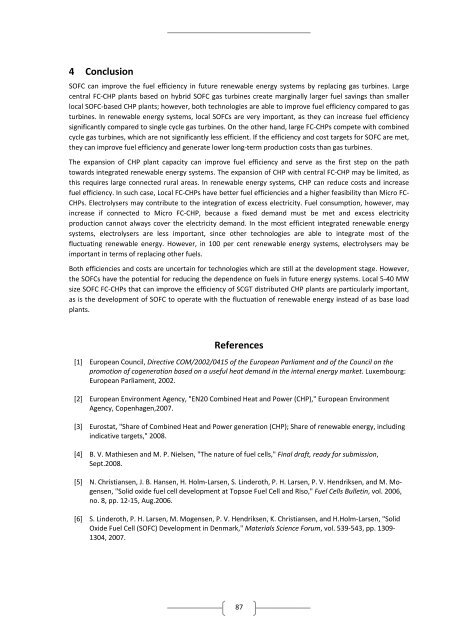Fuel cells and electrolysers in future energy systems - VBN
Fuel cells and electrolysers in future energy systems - VBN
Fuel cells and electrolysers in future energy systems - VBN
Create successful ePaper yourself
Turn your PDF publications into a flip-book with our unique Google optimized e-Paper software.
4 Conclusion<br />
SOFC can improve the fuel efficiency <strong>in</strong> <strong>future</strong> renewable <strong>energy</strong> <strong>systems</strong> by replac<strong>in</strong>g gas turb<strong>in</strong>es. Large<br />
central FC‐CHP plants based on hybrid SOFC gas turb<strong>in</strong>es create marg<strong>in</strong>ally larger fuel sav<strong>in</strong>gs than smaller<br />
local SOFC‐based CHP plants; however, both technologies are able to improve fuel efficiency compared to gas<br />
turb<strong>in</strong>es. In renewable <strong>energy</strong> <strong>systems</strong>, local SOFCs are very important, as they can <strong>in</strong>crease fuel efficiency<br />
significantly compared to s<strong>in</strong>gle cycle gas turb<strong>in</strong>es. On the other h<strong>and</strong>, large FC‐CHPs compete with comb<strong>in</strong>ed<br />
cycle gas turb<strong>in</strong>es, which are not significantly less efficient. If the efficiency <strong>and</strong> cost targets for SOFC are met,<br />
they can improve fuel efficiency <strong>and</strong> generate lower long‐term production costs than gas turb<strong>in</strong>es.<br />
The expansion of CHP plant capacity can improve fuel efficiency <strong>and</strong> serve as the first step on the path<br />
towards <strong>in</strong>tegrated renewable <strong>energy</strong> <strong>systems</strong>. The expansion of CHP with central FC‐CHP may be limited, as<br />
this requires large connected rural areas. In renewable <strong>energy</strong> <strong>systems</strong>, CHP can reduce costs <strong>and</strong> <strong>in</strong>crease<br />
fuel efficiency. In such case, Local FC‐CHPs have better fuel efficiencies <strong>and</strong> a higher feasibility than Micro FC‐<br />
CHPs. Electrolysers may contribute to the <strong>in</strong>tegration of excess electricity. <strong>Fuel</strong> consumption, however, may<br />
<strong>in</strong>crease if connected to Micro FC‐CHP, because a fixed dem<strong>and</strong> must be met <strong>and</strong> excess electricity<br />
production cannot always cover the electricity dem<strong>and</strong>. In the most efficient <strong>in</strong>tegrated renewable <strong>energy</strong><br />
<strong>systems</strong>, <strong>electrolysers</strong> are less important, s<strong>in</strong>ce other technologies are able to <strong>in</strong>tegrate most of the<br />
fluctuat<strong>in</strong>g renewable <strong>energy</strong>. However, <strong>in</strong> 100 per cent renewable <strong>energy</strong> <strong>systems</strong>, <strong>electrolysers</strong> may be<br />
important <strong>in</strong> terms of replac<strong>in</strong>g other fuels.<br />
Both efficiencies <strong>and</strong> costs are uncerta<strong>in</strong> for technologies which are still at the development stage. However,<br />
the SOFCs have the potential for reduc<strong>in</strong>g the dependence on fuels <strong>in</strong> <strong>future</strong> <strong>energy</strong> <strong>systems</strong>. Local 5‐40 MW<br />
size SOFC FC‐CHPs that can improve the efficiency of SCGT distributed CHP plants are particularly important,<br />
as is the development of SOFC to operate with the fluctuation of renewable <strong>energy</strong> <strong>in</strong>stead of as base load<br />
plants.<br />
References<br />
[1] European Council, Directive COM/2002/0415 of the European Parliament <strong>and</strong> of the Council on the<br />
promotion of cogeneration based on a useful heat dem<strong>and</strong> <strong>in</strong> the <strong>in</strong>ternal <strong>energy</strong> market. Luxembourg:<br />
European Parliament, 2002.<br />
[2] European Environment Agency, "EN20 Comb<strong>in</strong>ed Heat <strong>and</strong> Power (CHP)," European Environment<br />
Agency, Copenhagen,2007.<br />
[3] Eurostat, "Share of Comb<strong>in</strong>ed Heat <strong>and</strong> Power generation (CHP); Share of renewable <strong>energy</strong>, <strong>in</strong>clud<strong>in</strong>g<br />
<strong>in</strong>dicative targets," 2008.<br />
[4] B. V. Mathiesen <strong>and</strong> M. P. Nielsen, "The nature of fuel <strong>cells</strong>," F<strong>in</strong>al draft, ready for submission,<br />
Sept.2008.<br />
[5] N. Christiansen, J. B. Hansen, H. Holm‐Larsen, S. L<strong>in</strong>deroth, P. H. Larsen, P. V. Hendriksen, <strong>and</strong> M. Mo‐<br />
gensen, "Solid oxide fuel cell development at Topsoe <strong>Fuel</strong> Cell <strong>and</strong> Riso," <strong>Fuel</strong> Cells Bullet<strong>in</strong>, vol. 2006,<br />
no. 8, pp. 12‐15, Aug.2006.<br />
[6] S. L<strong>in</strong>deroth, P. H. Larsen, M. Mogensen, P. V. Hendriksen, K. Christiansen, <strong>and</strong> H.Holm‐Larsen, "Solid<br />
Oxide <strong>Fuel</strong> Cell (SOFC) Development <strong>in</strong> Denmark," Materials Science Forum, vol. 539‐543, pp. 1309‐<br />
1304, 2007.<br />
87

















